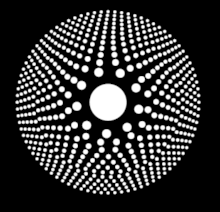Photon sieve

Photon Sieve
A photon sieve is a device for focusing light using diffraction and interference. It consists of a flat sheet of material full of pinholes that are arranged in a pattern which is similar to the rings in a Fresnel zone plate, but a sieve brings light to much sharper focus than a zone plate. The sieve concept, first developed in 2001,[1] is versatile because the characteristics of the focusing behaviour can be altered to suit the application by manufacturing a sieve containing holes of several different sizes and different arrangement of the pattern of holes.
Photon sieves have applications to Photolithography.[2] and are an alternative to lenses or mirrors in telescopes.[3]
References
- ↑ Sharper images by focusing soft X-rays with photon sieves, L. Kipp, M. Skibowski, R. L. Johnson, R. Berndt, R. Adelung, S. Harm, and R. Seemann, Nature 414, 184 (2001).
- ↑ Photon-sieve lithography, Rajesh Menon and Dario Gil, J. Opt. Soc. Am. A/Vol. 22, No. 2/February 2005
- ↑ Photon sieve telescope: imaging with 10 million pinholes, Geoff Andersen, 4 September 2006, SPIE Newsroom. DOI: 10.1117/2.1200608.0358
- Large optical photon sieve, Geoff Andersen, OPTICS LETTERS / Vol. 30, No. 22 / November 15, 2005
This article is issued from
Wikipedia.
The text is licensed under Creative Commons - Attribution - Sharealike.
Additional terms may apply for the media files.